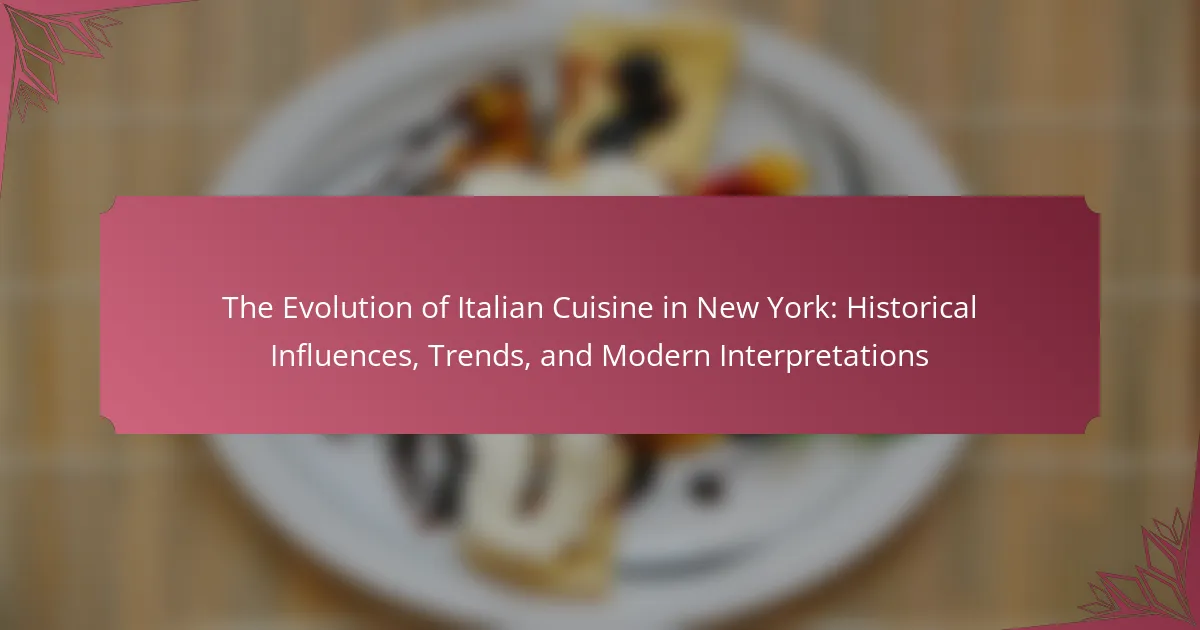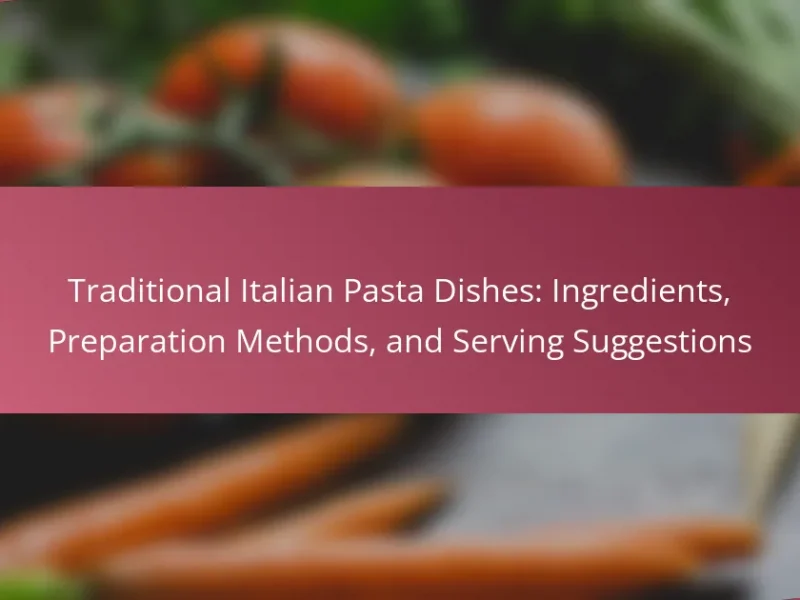The article examines the evolution of Italian cuisine in New York, highlighting its historical influences, trends, and modern interpretations. It traces the journey of Italian immigrants who introduced regional dishes such as pasta, pizza, and risotto in the late 19th century. As these traditional recipes adapted to local tastes and ingredients, Italian-American cuisine emerged, showcasing iconic dishes like spaghetti and meatballs. The article also explores the diversification of Italian cuisine by the 1970s, which included a focus on authentic regional cooking and the rise of fine dining establishments. Today, New York’s Italian food scene reflects a blend of tradition and innovation, emphasizing fresh, locally sourced ingredients and artisanal products.

What is the Evolution of Italian Cuisine in New York?
Italian cuisine in New York has evolved significantly since the late 19th century. Initially, Italian immigrants brought regional dishes from their home countries. These dishes included pasta, pizza, and risotto. Over time, New York’s Italian cuisine adapted to local tastes and ingredients.
In the early 20th century, Italian-American cuisine emerged, blending traditional recipes with American influences. Iconic dishes like spaghetti and meatballs became popular. The establishment of Italian delis and restaurants contributed to this culinary evolution.
By the 1970s, New York’s Italian cuisine began to diversify further. Chefs started to explore authentic regional Italian cooking. This shift led to the rise of fine dining Italian restaurants. Today, New York boasts a vibrant Italian food scene, reflecting both tradition and innovation.
The evolution of Italian cuisine in New York showcases a rich tapestry of cultural exchange. It highlights how immigrant communities shape and redefine culinary landscapes.
How did Italian cuisine first arrive in New York?
Italian cuisine first arrived in New York in the late 19th century. Italian immigrants brought their culinary traditions with them during this period. The first significant wave of immigration occurred from 1880 to 1920. Many of these immigrants settled in neighborhoods like Little Italy. They established restaurants and markets that featured traditional dishes. These establishments catered to both Italian communities and the broader population. Over time, Italian cuisine gained popularity across the city. By the early 20th century, it became a staple in New York’s diverse food scene.
What were the initial influences on Italian cuisine in New York?
The initial influences on Italian cuisine in New York came primarily from Southern Italian immigrants. These immigrants arrived in large numbers during the late 19th and early 20th centuries. They brought traditional recipes, cooking techniques, and regional ingredients. The cuisine was shaped by the availability of local produce and meats. Dishes like pizza and pasta became popular due to their affordability and simplicity. Italian markets and restaurants began to emerge, catering to both the Italian community and the broader public. This fusion of authentic Italian flavors with local influences laid the groundwork for modern Italian-American cuisine. The initial influences established a culinary foundation that continues to evolve today.
How did immigration patterns shape the culinary landscape?
Immigration patterns significantly shaped the culinary landscape by introducing diverse food traditions. Italian immigrants brought their culinary practices to New York in the late 19th and early 20th centuries. They established restaurants and food markets that featured traditional dishes like pasta and pizza. This integration led to the popularization of Italian cuisine among a broader audience. The demand for these foods influenced local ingredients and cooking methods. Over time, Italian cuisine evolved, incorporating elements from other immigrant groups. This fusion created a unique culinary identity in New York. Consequently, the city’s food culture became a reflection of its immigrant history.
What historical events influenced the development of Italian cuisine in New York?
The development of Italian cuisine in New York was significantly influenced by the mass immigration of Italians in the late 19th and early 20th centuries. This influx brought authentic regional recipes and cooking techniques from various parts of Italy. The establishment of Italian neighborhoods, such as Little Italy, provided a cultural hub for these culinary traditions. Additionally, the economic opportunities in the United States encouraged Italian families to open restaurants and markets. The Prohibition era also played a role, as many Italian immigrants turned to the restaurant business to sustain their livelihoods. Furthermore, the post-World War II period saw an increase in the popularity of Italian food among the broader American population. This led to the fusion of traditional Italian dishes with American ingredients and tastes. Overall, these historical events collectively shaped the rich and diverse landscape of Italian cuisine in New York.
How did World War II impact Italian food traditions?
World War II significantly impacted Italian food traditions by altering ingredient availability and culinary practices. The war caused food shortages and rationing in Italy. Many traditional ingredients became scarce or expensive. This led to the adaptation of recipes using more accessible ingredients. For example, pasta dishes often included less meat and more vegetables. Additionally, the influence of American soldiers introduced new foods and cooking styles to Italian cuisine. After the war, Italian immigrants in New York adapted these changes, blending traditional recipes with new influences. This fusion contributed to the evolution of Italian-American cuisine.
What role did the establishment of Italian neighborhoods play?
The establishment of Italian neighborhoods played a crucial role in shaping Italian cuisine in New York. These neighborhoods served as cultural hubs for Italian immigrants. They provided a space for preserving culinary traditions. Local markets and restaurants emerged, offering authentic Italian ingredients and dishes. This accessibility fostered community connections through shared meals. Additionally, it allowed for the adaptation of traditional recipes to local tastes. The neighborhoods also influenced the broader culinary landscape of New York. They contributed to the city’s identity as a melting pot of diverse cuisines.
What are the key trends in Italian cuisine in New York over the decades?
Italian cuisine in New York has evolved significantly over the decades. In the early 1900s, Italian immigrants brought traditional recipes and regional dishes. These dishes often featured simple ingredients and robust flavors. By the 1950s, Italian-American cuisine emerged, emphasizing dishes like spaghetti and meatballs. The 1980s saw a rise in regional Italian dining, showcasing distinct culinary traditions from Italy.
In the 1990s, the trend shifted towards authenticity, with chefs focusing on fresh, high-quality ingredients. The farm-to-table movement further influenced Italian cuisine in the 2000s, emphasizing local sourcing. Recently, there has been a growing interest in plant-based Italian dishes and gluten-free options. These trends reflect a blend of tradition and innovation in New York’s Italian culinary scene.
How have dining preferences shifted from traditional to modern interpretations?
Dining preferences have shifted from traditional to modern interpretations through various factors. Traditional Italian cuisine emphasized family-style meals and classic recipes. Modern dining trends focus on individual portions and innovative dishes. There is a growing demand for fusion cuisines that blend Italian with other culinary styles. Health-conscious choices have led to the popularity of lighter, plant-based options. Technology has influenced dining with the rise of food delivery and online reservations. Social media drives trends, showcasing visually appealing dishes. According to a 2020 survey, 70% of diners prefer unique dining experiences over traditional settings. This shift reflects a broader cultural change towards personalization and diversity in food choices.
What impact did food movements have on Italian cuisine in New York?
Food movements significantly transformed Italian cuisine in New York. These movements emphasized local, organic, and sustainable ingredients. This shift prompted Italian chefs to adopt fresh produce and artisanal products. Traditional recipes were reinterpreted to align with contemporary dietary trends. The farm-to-table movement inspired restaurants to source ingredients from nearby farms. This practice enhanced the quality and flavor of Italian dishes. Additionally, awareness of health and nutrition led to lighter, healthier versions of classic meals. Overall, food movements revitalized Italian cuisine, making it more diverse and innovative in New York.

How has Italian cuisine in New York evolved in modern times?
Italian cuisine in New York has evolved significantly in modern times. The traditional Italian dishes have been adapted to local tastes and ingredients. New York’s Italian restaurants now offer diverse interpretations of classic recipes. Modern chefs experiment with fusion cuisine, blending Italian with other culinary styles. There is an increased emphasis on fresh, locally sourced ingredients. Many establishments focus on artisanal and handmade products, such as pasta and bread. The rise of food culture has led to a greater appreciation for authentic regional dishes. Italian cuisine in New York reflects broader trends in health and sustainability. This evolution showcases the dynamic nature of culinary practices in urban settings.
What are the current popular dishes in New York’s Italian cuisine?
Current popular dishes in New York’s Italian cuisine include pasta alla vodka, chicken parmesan, and Neapolitan-style pizza. Pasta alla vodka features a creamy tomato sauce with vodka and is widely enjoyed. Chicken parmesan consists of breaded chicken cutlets topped with marinara sauce and melted cheese. Neapolitan-style pizza is characterized by its thin crust and fresh toppings. Other notable dishes are risotto and arancini, which showcase traditional Italian flavors. These dishes reflect the blend of authentic Italian recipes with local influences in New York.
Which traditional dishes have been reimagined in contemporary restaurants?
Pasta carbonara has been reimagined with alternative ingredients like zucchini noodles. Risotto is now often made with unconventional grains such as farro or quinoa. Pizza has evolved to include gourmet toppings like truffle oil and artisanal cheeses. Tiramisu is frequently adapted with flavors like matcha or salted caramel. These modern interpretations showcase creativity while honoring traditional Italian roots. Many contemporary restaurants in New York highlight these reimagined dishes, blending tradition with innovation.
How do chefs incorporate local ingredients into Italian recipes?
Chefs incorporate local ingredients into Italian recipes by sourcing seasonal produce from nearby farms. They emphasize freshness and flavor, which enhances traditional dishes. For example, tomatoes from local markets may replace canned varieties. Additionally, chefs often use regional cheeses and meats to create authentic flavors. This practice supports local agriculture and reduces carbon footprint. Many Italian restaurants in New York showcase dishes that highlight these local ingredients. By doing so, they preserve culinary traditions while adapting to modern tastes. This trend reflects a broader movement towards farm-to-table dining.
What influences are shaping the future of Italian cuisine in New York?
The future of Italian cuisine in New York is influenced by diverse factors. These include globalization, which introduces new ingredients and cooking techniques. The rise of food technology impacts how dishes are prepared and presented. Additionally, health trends are leading to lighter, more plant-based interpretations of traditional recipes. The influence of immigrant communities continues to shape authentic flavors and culinary practices. Sustainability is becoming a priority, with an emphasis on locally sourced ingredients. Culinary innovation is driven by chefs experimenting with fusion cuisines. Social media plays a significant role in popularizing new trends and dishes. Finally, evolving consumer preferences demand unique dining experiences that blend tradition with modernity.
How are cultural exchanges impacting Italian food trends?
Cultural exchanges are significantly shaping Italian food trends. The influx of diverse culinary influences introduces new ingredients and cooking techniques. For example, the integration of Asian flavors is evident in fusion dishes. Street food culture from various countries has also influenced Italian street food offerings. Additionally, social media amplifies the visibility of these trends, promoting unique combinations. This blending creates innovative dishes that appeal to a broader audience. Historical migrations have established Italian cuisine as a dynamic entity, continuously evolving with each exchange.
What role does technology play in modern Italian cooking?
Technology plays a significant role in modern Italian cooking by enhancing efficiency and precision. It allows chefs to experiment with new techniques and ingredients. Sous-vide cooking, for instance, ensures consistent results by controlling temperature accurately. Smart kitchen appliances streamline food preparation and cooking processes. Digital recipe platforms provide access to a vast array of traditional and contemporary dishes. Additionally, food preservation technologies help maintain the freshness of ingredients. The use of social media allows chefs to share innovative recipes and connect with a broader audience. Overall, technology transforms traditional Italian cooking into a more dynamic and accessible culinary experience.

What can we learn from the evolution of Italian cuisine in New York?
The evolution of Italian cuisine in New York reveals cultural adaptation and fusion. Italian immigrants adapted traditional recipes to local ingredients and tastes. This led to the creation of iconic dishes like pizza and spaghetti and meatballs. The cuisine reflects the socio-economic conditions of the immigrant communities. Over time, Italian cuisine in New York evolved into a diverse culinary landscape. It now includes regional variations and modern interpretations. This evolution showcases the dynamic nature of food culture in urban settings. The impact of Italian cuisine is evident in New York’s restaurant scene today.
How can home cooks replicate traditional Italian recipes?
Home cooks can replicate traditional Italian recipes by using authentic ingredients and following traditional cooking methods. First, sourcing high-quality ingredients is essential. This includes using fresh produce, authentic Italian cheeses, and imported pasta. Next, understanding the traditional techniques is crucial. Techniques such as slow simmering sauces and hand-rolling pasta enhance flavor. Additionally, following classic recipes from reputable sources ensures authenticity. Many traditional Italian recipes are rooted in regional cooking, so exploring specific regional dishes can provide a deeper understanding. Historical cookbooks and culinary traditions passed down through generations serve as valuable resources. By combining these elements, home cooks can create dishes that closely resemble those found in Italy.
What tips are essential for making authentic Italian dishes at home?
Use high-quality ingredients to make authentic Italian dishes at home. Fresh produce, quality olive oil, and authentic cheeses are crucial. Understand the importance of traditional cooking methods. Techniques such as slow cooking and proper seasoning enhance flavors. Learn regional variations of Italian cuisine. Each region has unique dishes and ingredients. Embrace simplicity in recipes. Authentic Italian cooking often focuses on a few key ingredients. Practice patience during preparation. Many Italian dishes require time to develop flavors. Lastly, enjoy the process of cooking. This reflects the Italian philosophy of food as a communal experience.
Which resources are best for learning about Italian cooking techniques?
The best resources for learning about Italian cooking techniques include cookbooks, online courses, and culinary schools. Notable cookbooks like “Essentials of Classic Italian Cooking” by Marcella Hazan provide foundational recipes and techniques. Online platforms such as MasterClass offer classes from renowned chefs like Lidia Bastianich. Culinary schools, including the Culinary Institute of America, offer formal training in Italian cuisine. These resources are widely recognized for their quality and depth in teaching authentic Italian cooking methods.
How can understanding this evolution enhance dining experiences?
Understanding the evolution of Italian cuisine in New York enhances dining experiences by providing context to the dishes served. This evolution reflects historical influences, such as immigration patterns and regional variations. Knowledge of these influences allows diners to appreciate the cultural significance behind each meal. For example, recognizing how Neapolitan pizza differs from Sicilian styles enriches the dining experience. Additionally, understanding modern interpretations highlights innovation within traditional recipes. This awareness fosters a deeper connection to the food and the chefs who create it. Ultimately, informed diners are more likely to engage with the cuisine meaningfully.
What should diners look for when exploring Italian restaurants in New York?
Diners should look for authentic ingredients and traditional recipes when exploring Italian restaurants in New York. Authentic ingredients often include high-quality olive oil, San Marzano tomatoes, and imported cheeses. Traditional recipes reflect regional Italian cooking styles, such as Neapolitan pizza or Sicilian pasta dishes. Diners should also consider the restaurant’s ambiance, which can enhance the dining experience. A welcoming atmosphere often mirrors the Italian dining culture of family and community. Additionally, attentive service is crucial for an enjoyable meal. Many reputable establishments have knowledgeable staff who can recommend dishes and wine pairings. Finally, diners might seek out restaurants with a strong local reputation or positive reviews, indicating consistent quality and customer satisfaction.
How can appreciation of history enrich the enjoyment of Italian cuisine?
Appreciation of history enriches the enjoyment of Italian cuisine by providing context to its flavors and techniques. Understanding the origins of dishes reveals cultural influences that shaped them. For instance, Italian cuisine has roots in ancient Roman, Greek, and Arab culinary practices. These historical connections enhance the dining experience by fostering a deeper connection to the food. Knowledge of regional variations highlights how geography and history influence local ingredients and cooking methods. Recognizing the impact of immigration on Italian cuisine in New York illustrates how traditions evolved over time. This historical perspective allows diners to appreciate the stories behind each dish. Ultimately, it transforms a meal into a journey through time and culture.
The main entity of the article is Italian cuisine in New York, which has undergone significant evolution since the late 19th century. The article outlines how Italian immigrants initially introduced regional dishes that adapted over time to local tastes, leading to the emergence of Italian-American cuisine. Key historical events, such as mass immigration and World War II, shaped the culinary landscape, while modern trends emphasize authenticity, local sourcing, and innovative interpretations of traditional recipes. The article also highlights the impact of cultural exchanges and technology on contemporary Italian cooking, providing insights into popular dishes and dining preferences in New York today.


